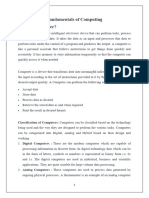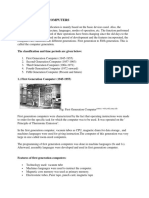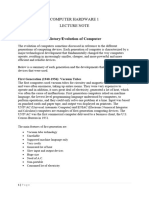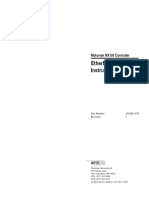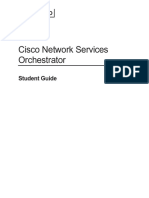Generations of Computers
Introduction
In computers, we use the term “generation” to show the evolution of technology. Earlier, the
generation term was used to distinguish the computers in terms of varying hardware but now
it all together includes the hardware and software which makes up a computer system. After
centuries of evolution that began in the 16 th century, the contemporary computer has taken its
current form.
History of Computer Generation
The word ‘computer’ was first used in the 16th century for a person who used to do
calculations until the 20th century. Women were hired as human computers to carry out all
forms of calculations and computations. By the end of the 19 th century, the word ‘computer’
was used for the machines that did calculations. Nowadays we use the word for the
programmable digital devices that run on electricity.
Before computers were invented, sticks, stones, and bones were used as counting tools. With
the evolution of human intellect and the advancement of technology, more computing devices
were produced.
There are 5 Generations of computers and all of them have been discussed below along with
their features.
1. First Generation of Computers
The 1st Generation Computers were introduced using the technology of vacuum tubes which
can control the flow of electronics in a vacuum. These tubes are usually used in switches,
amplifiers, radios, televisions, etc. The First Generation of Computer was very heavy and
large and were not ideal for programming. They used basic programming and didn’t have an
operating system, which made it tough for users to do programming on them. The 1 st
Generation Computers required a big room dedicated to them and also consumed a lot of
electricity.
Some examples of main first-generation computers are-
ENIAC: Electronic Numerical Integrator and Computer, built by J. Presper Eckert
and John V. Mauchly which contained 18,000 vacuum tubes
EDVAC: Electronic Discrete Variable Automatic Computer, designed by Von
Neumann.
UNIVAC: Universal Automatic Computer, developed by Eckert and Mauchly in
1952.
Characteristics of 1st Generation Computers
1
� These computers were designed using vacuum tubes.
Programming in these computers was done using machine languages.
The main memory of 1st Generation Computers consisted of magnetic tapes and
magnetic drums.
Paper tapes and Punched cards were used as input/output devices in these computers.
These compu6ters were very huge but worked very slowly.
Examples of 1st Generation Computers are IBM 650, IBM 701, ENIAC, UNIVAC1,
etc.
2. Second Generation Computers
The Second Generation of Computers revolutionized as it started using the technology of
transistors instead of bulky vacuum tubes. Transistors are devices made of semiconductor
materials that open or close a circuit. These transistors were invented in the Bell Labs which
made the Second Generation Computer powerful and faster than the previous
ones.Transistors made these computers smaller and generated less heat compared to the
vacuum tubes they replaced. The Second Generation of Computers also introduced the use of
CPU, memory and input/output units. The programming languages used for the second-
generation computers were FORTRAN (1956), ALGOL (1958), and COBOL (1959).
Characteristics of 2nd Generation Computers
The Second Generation computers used the technology of Transistors.
Machine language and Assembly Languages were used for these computers.
Magnetic core and magnetic tape/disk were used for memory storage.
The Second Generation Computers were smaller in size, consumed less power and
generated less heat.
Magnetic tape and punched cards were used as input/output devices.
Some of the examples are PDP-8, IBM1400 series, IBM 7090 and 7094, UNIVAC 1107,
CDC 3600wer etc.
2
�3. Third Generation of Computers
The evolution of Third Generation Computers took place with a shift from transistors to
integrated circuits also called IC. The Third Generation of Computers was known for being
very fast and dependable. These computers used Integrated Circuits (ICs) made from silicon,
known as silicon chips. Each chip contains many tiny electronic parts, like transistors,
registers, and capacitors, all on a thin piece of silicon.
This made computers in this generation more powerful and efficient with better memory.
During this time, programming languages like BASIC (Beginners All-purpose Symbolic
Instruction Code) were commonly used. Also, Minicomputers, which are smaller than
mainframes but still powerful, were introduced. Overall, this generation marked significant
improvements in speed, reliability, and capabilities of computers.
Characteristics of 3rd Generation Computers
These computers were built using Integrated Circuits (ICs).
High-level programming languages were used for programming on these computers.
Large magnetic core and magnetic tape/disk were used for memory storage.
Magnetic tape, monitor, keyboard, printer, etc were used as input/output devices.
Some of the examples of Third Generation Computers are IBM 360, IBM 370, PDP-11,
NCR 395, B6500, UNIVAC 1108, etc.
3
�4. Forth Generation of Computers
The period from 1972 to 2010 is considered the period of the fourth generation of computers.
Microprocessor technology was used to develop the Fourth Generation of Computers. The
foremost advantage of these computers is that the microprocessor can contain all the circuits
required to perform arithmetic, logic, and control functions on one chip. In the Fourth
Generation, computers became very small in size and also became portable.
Technologies like multiprocessing, multiprogramming, time-sharing, operating speed, and
virtual memory were also introduced by then. .During the fourth generation, private
computers and computer networks became a reality.
Characteristics of 4th Generation Computers
The Fourth Generation Computers have been developed using the technology of Very-
large-scale integration (VLSI) and the microprocessor (VLSI has thousands of transistors
on a single microchip).
Semiconductor memory such as RAM, ROM, etc was used for memory storage.
Input/output devices such as pointing devices, optical scanning, keyboard, monitor,
printer, etc were introduced.
Some examples of Fourth Generation Computers are IBM PC, STAR 1000, APPLE II,
Apple Macintosh, Alter 8800, etc.
5. Fifth Generation of Computers
The Fifth Generation of Computers has been built using the technology called Artificial
Intelligence (AI). This technology encourages computers to behave like humans. Some of the
applications of AI have been seen in features like voice recognition, entertainment, etc. The
speed of the Fifth Generation of Computers is the highest while the sizes are the smallest. A
big improvement has been noticed so far over the years in the various generations of
computers in the aspect of speed, accuracy dimensions, etc.
Characteristics of 5th Generation Computers
4
� The 5th Generation Computers have been built based on artificial intelligence, use the
Ultra Large-Scale Integration (ULSI) technology and parallel processing method (ULSI
has millions of transistors on a single microchip and the Parallel processing method uses
two or more microprocessors to run tasks simultaneously).
These computers understand natural language (human language).
The Fifth-generation computers are portable and smaller in size.
Trackpad (or touchpad), touchscreen, pen, speech input (recognize voice/speech), light
scanner, printer, keyboard, monitor, mouse, etc are used as Input/Output devices.
Examples of 5th Generation Computers are Desktops, laptops, tablets, smartphones, etc.
Reference
https://www.careerpower.in/school/computer/generation-of-computer






